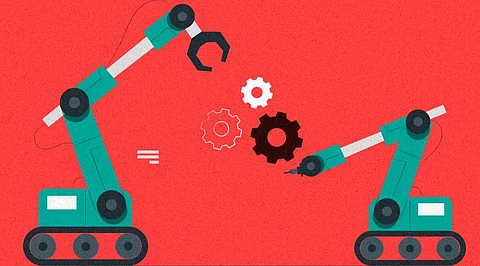

AI, RPA, and machine learning, you must have heard these words echoing in the tech industry. Be it blogs, websites, videos, or even product descriptions, disruptive technologies have made their presence bold. The fact that we all have AI-powered devices in our homes is a sign that the technology has come so far.
If you are under the impression that AI, robotic process automation, and machine learning have nothing in common, then here's what you need to know, they are all related concepts. Oftentimes, people use these names interchangeably and incorrectly which causes confusion among businesses that are looking for the latest technological solutions.
Understanding the differences between AI, ML, and RPA tools will help you identify and understand where the best opportunities are for your business to make the right technological investment.
According to IBM, "Robotic process automation (RPA), also known as software robotics, uses automation technologies to mimic back-office tasks of human workers, such as extracting data, filling in forms, moving files, etc. It combines APIs and user interface (UI) interactions to integrate and perform repetitive tasks between enterprise and productivity applications. By deploying scripts which emulate human processes, RPA tools complete autonomous execution of various activities and transactions across unrelated software systems."
In that sense, RPA tools enable highly logical tasks that don't require human understanding or human interference. For example, if your work revolves around inputting account numbers on a spreadsheet to run a report with a filter category, you can use RPA to fill the numbers on the sheet. Automation will mimic your actions of setting up the filter and generate the report on its own.
With a clear set of instructions, RPA can perform any task. But there's one thing to remember, RPA systems don't have the capabilities to learn as they go. If there is a change in your task, (for example if the filter has changed in the spreadsheet report), you will have to manually input the new set of instructions.
The highest adopters of this technology are banking firms, financial services, insurance, and telecom industries. Federal agencies like NASA have also started using RPA to automate repetitive tasks.
According to Microsoft, "Artificial Intelligence is the ability of a computer system to deal with ambiguity, by making predictions using previously gathered data, and learning from errors in those predictions in order to generate newer, more accurate predictions about how to behave in the future".
In that sense, the major difference between RPA and AI is intelligence. While these technologies efficiently perform tasks, only AI can do it with similar capabilities to human intelligence.
Chatbots and virtual assistants are two popular uses of AI in the business world. In the tax industry, AI is making tax forecasting increasingly accurate with its predictive analytics capabilities. AI can also perform thorough data analysis which makes identifying tax deductions and tax credits easier than before.
According to Gartner, "Advanced machine learning algorithms are composed of many technologies (such as deep learning, neural networks, and natural language processing), used in unsupervised and supervised learning, that operate guided by lessons from existing information."
Machine learning is a part of AI, so the two terms cannot be used interchangeably. And that's the difference between RPA and ML, machine learning's intelligence comes from AI but RPA lacks all intelligence.
To understand better, let us apply these technologies in a property tax scenario. First, you can create an ML model based on a hundred tax bills. The more bills you feed the model, the more accurately it will make predictions for the future bills. But if you want to use the same machine learning model to address an assessment notice, the model will be of no use. You would then have to build a new machine learning model that knows how to work with assessment notices. This is where machine learning's intelligence capabilities draw a line. Where ML fails to recognize the similarities of the document, an AI application would recognize it, thanks to its human-like interpretation skills.
The healthcare industry uses ML to accurately diagnose and treat patients, retailers use ML to make the right products available at the right stores at the right time, and pharmaceutical companies use machine learning to develop new medications. These are just a few use cases of this technology.
No, but they can work together. The combination of AI and RPA is called smart process automation, or SPA.
Also known as intelligent process automation or IPA, this duo facilitates an automated workflow with advanced capabilities than RPA using machine learning. The RPA part of the system works on doing the tasks while the machine learning part focuses on learning. In short, SPA solutions can learn to perform a specific task with the help of patterns.
The three technologies, AI, RPA, and ML, and the duet, SPA hold exciting possibilities for the future. But only when companies make the right choice, the rewards can be reaped. Now that you have an understanding of the various capabilities of these technologies, adapt and innovate.
